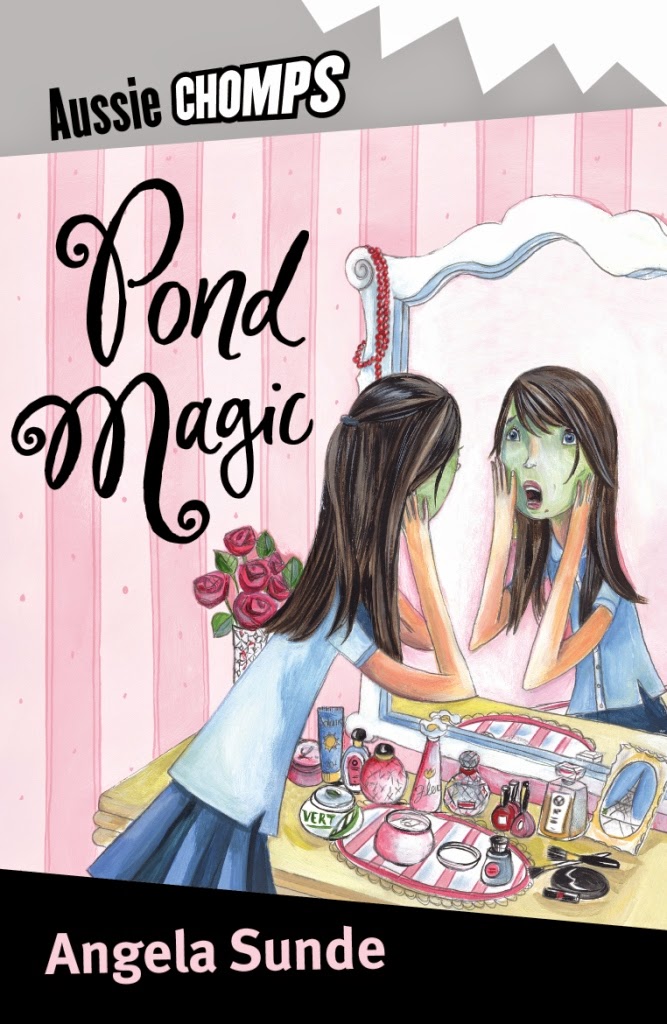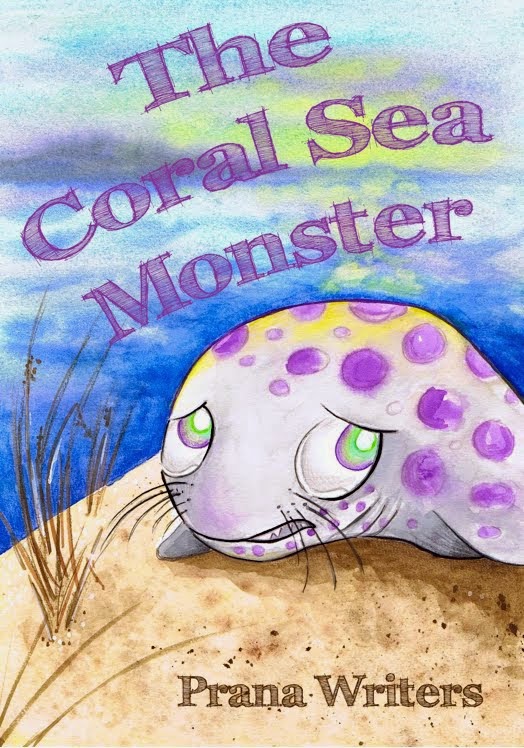| James performing for Edith on the platform she had built onto her veranda rail (from Ambrose Pratt's book 1932). |
Inspired by this true story, author Jackie Kerin has written a beautiful picture book rendition, Lyrebird! A True Story, illustrated by award-winning Peter Gouldthorpe and published by Museum Victoria.
‘Well heavens to Betsy! ..
You’re no ordinary chook!’When Edith met a cheeky young lyrebird on her garden path, she could not guess that he would one day be known as ‘A Miracle of the Dandenongs’.
Soon, James the lyrebird was singing and dancing for Edith, mimicking the birdsongs and other sounds that echoed through the bush. Word of their friendship spread and people travelled from near and far to film and record James. But with people came change ...
And today we are very privileged to host its illustrator, Peter Gouldthorpe Under the Apple Tree.
An accomplished landscape artist and illustrator, Peter Gouldthorpe's long and successful career as a children's book illustrator began when he was a stay-at-home dad to his eight month old daughter. His desire to reach a wider audience than the private collections of the privileged few was realised and Peter is now also well-known for his trompe l'oeil murals which lift the walls, alleys, restaurants and hospitals of his home state of Tasmania.
Shortlisted for the Children's Book Council of Australia Awards four times, Peter won Picture Book of the Year in 1994 for the book First Light, written by Gary Crew.
Hi Peter!
Welcome to my blog, Under the Apple Tree. Thanks so much for agreeing to pop in. Grab yourself a spot on the picnic blanket; there’s always apple pie for visitors.
Welcome to my blog, Under the Apple Tree. Thanks so much for agreeing to pop in. Grab yourself a spot on the picnic blanket; there’s always apple pie for visitors.
I'm pleased to be here, Angela. Thanks for inviting me.
I was thrilled to receive your latest illustrated picture book, Lyrebird! A True Story. Congratulations on its release!
My initial read left me entranced by your evocative artwork and Jackie’s touching true story. Since then I’ve had a long and more careful look and, not surprisingly, I’ve discovered loads of details that I’m just itching to ask you about.
Thank you. Ask away!
Thank you. Ask away!
With a wash of yellow background on each page unifying the story, the individual pages are varied in layout and perspective. How much input did you have regarding the placements of the various images in the page layouts (and cover) whilst working with the book designer, Elizabeth Dias, and what influenced your decisions?
The layout of Lyrebird! A True Story was quite tricky because there are at least three different elements I had to juggle. First, the basic run of the story, second, Edith's diary and thirdly, letters and Jackie's notes at the end. I worked up a rough of the whole book and then Jackie, Elizabeth and Melanie from Museum Victoria all made suggestions. I accommodated as many of their suggestions as I could but not all.
I think you made a great team. And regarding perspective, whilst the story is told from the old lady, Edith’s, I’ve noticed the visual perspective shown in the illustrations alternates between Edith’s and the lyrebird, James’. Was this a conscious decision?
It was less a conscious decision and more a practicality thrust upon me by the difference of scale between Edith and James. If you imagine the scenes with James in the background, he is going to be rather insignificant. Also, the perspective of having James in the foreground not only "tells" his story but gives the reader a more intimate relationship with him.
I certainly felt a strong connection to James because of this.
The story is interspersed with sepia sketches and notes torn from Edith’s notebook, happily marrying the narrative to the factual without seeming forced. This lends a 1930’s feel to the visual narrative. Would you be able to share your research methods for capturing this time in your illustrations for Lyrebird! A True Story?
Jackie's text came to me fully formed so all of the notebook illustrations and text were fully formed. The only contribution I made was the egg in the nest on the title page, which I hope readers will deduce could be wee James. The suggestion was for sepia ink drawings, which I thought remarkable of Edith to be carrying pen AND ink around in her apron! I suggested pencil, but everyone thought pen and ink more aesthetic for the book.
The story’s arc traverses two years and nine seasonal changes. With the careful use of light, shade and colour you have taken the reader on a journey of progression through the seasons as James develops from a young lyrebird with “a plain-tail” to a magnificent adult male with spectacular plumage. His tail feathers seem to have grown larger and lightened in tone as he matured and grew new ones.
Did you work from real life, museum specimens or photographs when developing James’ character? And which medium have you used? Why did you choose this medium?
I had to visit the museum and looked at taxidermied specimens. The basic bird I could get my head around easily, but the two lyre-shaped feathers did my head in, even after I had studied and photographed them, because they are see-through and not see-through, and I know that doesn't even sound like it makes sense.
The medium is just acrylic paint, which doesn't necessarily give the best result, but time is always a factor with illustrating or else I'd be tempted to use oil paints.
Victoria’s Dandenong Ranges are exquisitely evoked in the opening image where the old gardener, Edith is hoeing her mountaintop garden. Beautifully rich in colour and depth, you have captured the blue hues of the distant valleys below as black cockatoos nest in a gum. Are the Dandenongs a familiar subject for your artwork, as you have certainly captured their essence?
Victoria’s Dandenong Ranges are exquisitely evoked in the opening image where the old gardener, Edith is hoeing her mountaintop garden. Beautifully rich in colour and depth, you have captured the blue hues of the distant valleys below as black cockatoos nest in a gum. Are the Dandenongs a familiar subject for your artwork, as you have certainly captured their essence?
No, the Dandenongs aren't exactly familiar. I grew up in Sydney, but we did go for picnics up there when we visited my grandparents, and the gum trees always impressed with their long streamers of bark dangling down. I now live in Tasmania and some of our rainforest has a very similar feel to it. So similar that during the 1930's (I think) an "insurance"population of lyrebirds were brought here and are flourishing in the two areas where they were released.
My favourite illustration is ‘winter’ on page 11. The lyrebird, James’ beautiful tail plumage stretches towards the reader, drawing our attention upwards to the focal point of Edith looking over her shoulder as she prunes roses. And though the colours are muted, the red scarf and handle of her secateurs capture our attention, while the cloud of steam escaping from James’ mouth as he sings steals the show.
Peter, would you be able to share your favourite illustration with my readers and show us some preliminary sketches and roughs?
You might be cross with me, but I seem to have thrown the roughs away. My studio draws are almost full and I actually don't like my rough sketches. They aren't things of beauty like some illustrators are. I think my favourite would be pages 8-9, perhaps because I like gardening myself and this opening encapsulates that or maybe it just feels happy and sunny.
You might be cross with me, but I seem to have thrown the roughs away. My studio draws are almost full and I actually don't like my rough sketches. They aren't things of beauty like some illustrators are. I think my favourite would be pages 8-9, perhaps because I like gardening myself and this opening encapsulates that or maybe it just feels happy and sunny.
Ha ha! Of course I'm not cross. I've noticed illustrators often bring an additional narrative thread to a picture book. In Lyrebird! A True Story you have added a variety of other birds to the visual narrative, with each scene featuring at least one, and included a visual reference at the end of the book. Besides showing the rich variety of fauna, I love how this gives the children reading Lyrebird! A True Story the opportunity to search for and identify the birds on each page. Is this something you commonly include in non-fiction picture books?
The Spot-the-bird Game was all Jackie's idea and made for a lot of extra work for me. Thanks Jackie! I sometimes put in extra details in other books, but only if I think it is right for the overall book.
As the story progresses and civilisation encroaches upon Edith’s world the very real danger James may face is portrayed in the image of spring below. The clever placement of the illustration’s elements (using the golden spiral/curve of composition) leads the eye along the lyrebird’s lost tail feather to Edith’s arm, up her body to the gang-gang cockatoos feeding in a gum tree and then down the rising tendril of smoke to the devastated landscape below. This makes you wonder whether James’ fate is sealed.
Peter, how much does composition influence your choices when sketching roughs? Or does it simply come naturally to you?
Composition is/was something I always consider in my books as well as my own paintings. It used to be very conscious and long considered; now I seem to do it more intuitively.
I went straight from Lyrebird! A True Story to a book on Mawson, hence my haste in cleaning up the mess of books, sketches and references as soon as I'd finished. Mawson will be a companion to a book I wrote and illustrated last year on Scott. It comes out around April 2013. And now I'm painting lots of Tasmanian fish for the Department of Fisheries.
Peter, thank you so much once again for your visit. I wish you all the best with the release of Lyrebird! A True Story and your other works in progress.
You're very welcome, Angela. It was lovely to be here.
You're very welcome, Angela. It was lovely to be here.














